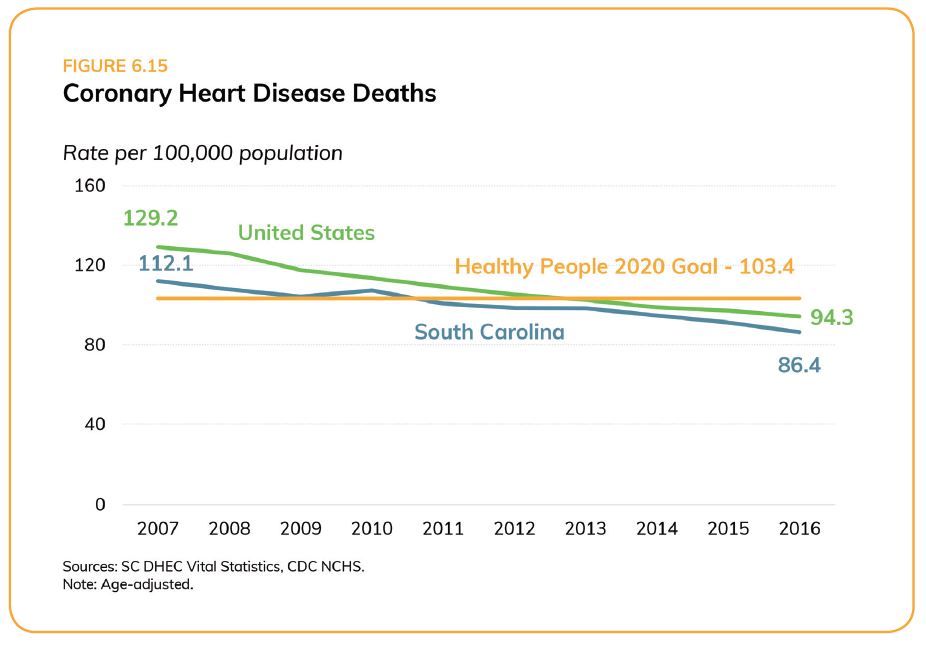Our next installment of the 2018 Live Healthy State Health Assessment summaries covers chronic disease and risk factors. Because this section lists many chronic diseases that affect South Carolina, we will summarize in three sections. Check out our previous posts: overview of the report, South Carolina demographics, leading causes of death and hospitalization, cross-cutting, access to healthcare, and maternal and infant health.
Key Findings
Obesity
- South Carolina had the 12th highest adult obesity rate in the nation in 2016.
- In 2016, the prevalence of obesity among non-Hispanic Blacks was 42.8% and was higher compared to non-Hispanic Whites (30.2%).
- The prevalence of obesity was higher in adults with an annual household income less than $15,000 (40.8%) than among those with income $50,000 and higher (28.4%).
Prediabetes
Prediabetes, sometimes called “borderline diabetes” is a condition in which someone has a blood sugar (glucose) level above normal but not yet in the diabetes range. People with prediabetes are more likely to develop type 2 diabetes, heart disease, or experience a stroke. Without lifestyle changes to improve their health, 15% to 30% of people with prediabetes will develop type 2 diabetes within five years.
- The prevalence of adults in South Carolina diagnosed with prediabetes increased from 6.7% in 2011 to 9.4% in 2016.
- In 2016, the prevalence of prediabetes was higher in non-Hispanic Blacks (12.5%) compared to non-Hispanic Whites (8.5%).
- The prevalence of prediabetes was higher in those with a disability (14.7%) than those without a disability (6.9%).
Diabetes

- From 2011 to 2016, South Carolina adults with diabetes have remained higher than the median range of the United States.
- The prevalence of diabetes was higher among adults aged 65 or older than among those under age 65.
- In 2016, the prevalence of diabetes was higher in non-Hispanic Blacks (16.9%) than in non-Hispanic Whites (11.7%).
Hypertension

Hypertension, commonly known as “high blood pressure,” is often called the silent killer because, apart from extreme cases, it has no symptoms. Nearly one in three United States adults have high blood pressure.
- More than one-third (39.3%) of adults in South Carolina had hypertension in 2016.
- Seventeen counties had a prevalence of hypertension higher than the state average at 38.7%.
- In 2016, the prevalence of hypertension increased with age.
Arthritis
Arthritis is the term used to describe more than 100 diseases and conditions that affect joints, the tissues that surround the join, and other connective tissue.
- The percentage of South Carolina adults who have been told they have arthritis, rheumatoid arthritis, gout, lupus, or fibromyalgia increased from 27.9% in 2011 to 30.1% in 2016. The median percentage of arthritis was 25.8% in the United States in 2016.
- Over 57% of adults ages 65 years or older reported having arthritis in 2016.
- The prevalence among disabled adults (56.2%) was three times higher than those adults who were not disabled (16.8%).
Heart Disease
About 610,000 Americans die each year from heart disease. Heart disease is the leading cause of death and disability in the United States.

- South Carolina had a lower death rate compared to the United States (94.3 per 100,000) and met the Healthy People 2020 goal of 103.4 coronary heart disease deaths per 100,000 population in 2016.
- Men (123.3 per 100,000) had a higher death rate than women (57.6 per 100,000) in 2016.
- Non-Hispanic Blacks (96.0 per 100,000) experienced a higher death rate than non-Hispanic Whites (85.7 per 100,000).
Stroke

Stroke was the fifth leading cause of death in the United States in 2016, and is a leading cause of serious, long-term disability in the United States. About 795,000 people in the United States have a stroke each year.
- In 2016, South Carolina had the sixth highest stroke death rate in the nation and is part of the “Stroke Belt,” a group of Southeastern states with high death rates.
- Stroke was the fifth leading cause of death in South Carolina, resulting in 2,627 deaths in 2016.
- Stroke resulted in 16,484 hospitalizations in South Carolina in 2016, with charges of more than $952 million.
In our next section, we will summarize nutrition, physical activity, and cigarette smoking in South Carolina adults. For more detailed information about chronic diseases and risk factors that affect our state, visit https://www.livehealthysc.com/uploads/1/2/2/3/122303641/chronic_disease_and_risk_factors_sc_sha.pdf.










